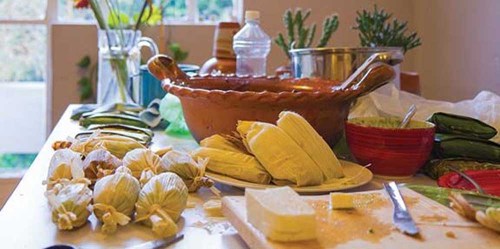’Tis the season for tamales
Published 5:00 pm Saturday, November 30, 2024

- 1337076286
Angelica Zurita, owner of the La Laguna Mexican restaurant in Enterprise, knows something about tamales. They aren’t just about feeding a large family on a budget, she says. It’s more about the tradition of eating together as a family. “Not just your family, but your sister’s family and her kids.”
Thanksgiving is not celebrated in Mexico, but at Christmas “the house is full of people. You gather at Mom’s house” and everyone comes from all over, she says. Some families make more than 200 tamales during the holiday season to share with friends and family members.
Trending
Zurita was born in Mexico but grew up in the United States. There wasn’t a lot of money back when she was growing up, so things were done by hand. “Years ago, the corn was ground and then you soaked it” to make the tamale dough, called masa harina. Growing up, she remembers peppers for the tamales hanging out to dry on strings along the kitchen ceiling.
Families could make a large batch of tamale dough and fill it with Mexican cheese (queso), which was affordable. A small amount of dough “could feed a whole family.” If there was more money, she says, meat could be added. The original tamale recipe contained no meat, “just a piece of cheese and a jalapeno pepper” for filling. Now, she says, the options are endless.
Dried corn husks, found in the Hispanic food section at most grocery stores, are used to wrap the tamales before steaming, then removed and discarded before eating. Then there’s the lard. Tamales are traditionally made with lard from pork fat, she says. Check the meat section for two types: deodorized and nondeodorized. The latter “smells just like cooked bacon,” she says. Spices such as cumin or garlic salt can also be added to the dough for flavor.
Tamales (tamal in Spanish) originated in Mesoamerica as early as 8000 BC. The Aztec and Mayan civilizations used them as easily portable food for hunting trips and traveling long distances. Ancient civilizations considered corn as a central part of their identities and so brought tamales into their festivals and religious ceremonies.
Tamales can either be made savory or sweet, depending on the filling used. Why not give them a try this holiday season? Feliz Navidad!
Trending
Ingredients
A bowl of your choice of filling (see Note below)
4 cups masa harina (flour made from soaked and dried corn kernels, mixed with water to make a corn dough)
3 cups of warm chicken broth
2 cups of lard
3 Tbs. vegetable oil
2 red bell peppers, chopped.
1 jalapeno pepper, seeded and minced
1 red onion, diced.
2 cups fresh corn kernels
½ cup cilantro, chopped
Kosher salt to taste
Kitchen twine or string
50 corn husks, soaked in warm water.
Note: Before you start, you’ll need to prepare a batch of filling. There are many possibilities, from a simple cheese filling, to shredded or ground meat, or vegetarian options. You’ll find some ideas online at muybuenoblog.com or just try a search for “tamale fillings” and see what looks good. Filling can be made the same day or ahead of time and set aside until you are ready to start on the tamales. Since this is a separate recipe, factor in the time needed to make both the filling and tamales.
Directions
Heat oil in a skillet over high heat and cook peppers and onion for 4-5 minutes until mixture softens. Add the corn and cilantro and season with salt. Remove from heat.
In a large bowl reconstitute the masa harina by adding the warm broth. Beat with a wooden spoon until the dough is stiff, but smooth. Add more broth if necessary but keep the mixture firm.
In another bowl, beat the lard using a paddle attachment of a mixer, until it’s very fluffy, for about 3 minutes. Continue to beat while adding the masa harina mixture. The mix should be light and fluffy. To test if it’s mixed, drop a teaspoon of the mixture in a glass of water. If it floats, it’s mixed well. If not, keep beating. Set mixture aside.
Gently fold the pepper and corn mixture into the prepared masa until combined, being careful not to overwork the dough.
(Here’s where the kids can help.) On a clean, dry surface, lay out the softened corn husks. Spread approximately 2-3 tablespoons of prepared masa down each husk. Flatten slightly.
Spread a few spoonfuls of your filling on top of the masa layer. How much is a matter of taste, so try different amounts to figure out your preference.
Roll each tamale lengthwise and twist the ends, similar to a tootsie roll wrapper. Tie the ends with twine or string. Set aside.
Fill a large pot, fitted with a large steamer basket, with about two inches of water. Set on medium heat. Once the water is boiling, place the tamales (as many as will fit without over-stacking) in the steamer basket. Reduce heat to simmer and steam tamales for 45 to 60 minutes. Add additional water if necessary, to maintain steam. Makes 50 tamales.









